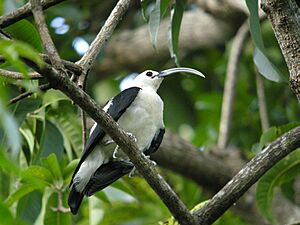Sickle-billed vanga facts for kids
Quick facts for kids Sickle-billed vanga |
|
|---|---|
 |
|
| Conservation status | |
| Scientific classification | |
| Genus: |
Falculea
|
| Species: |
palliata
|
The sickle-billed vanga (Falculea palliata) is a special type of bird. It belongs to the vanga family, called Vangidae. This bird is the only species in its group, known as the Falculea genus. You can only find the sickle-billed vanga on the island of Madagascar. It lives in tropical dry forests and areas with dry shrubland.
Contents
About the Sickle-billed Vanga's Family
The sickle-billed vanga was first described by a scientist named Isidore Geoffroy Saint-Hilaire in 1836. He also created the group Falculea just for this bird. There are no different types or subspecies of this vanga.
Long ago, some scientists thought this bird was related to crows and jays. These birds are in the Corvidae family. But now we know the sickle-billed vanga is part of the vanga family. Its closest relatives include the Bernier's vanga, the white-headed vanga, and three species from the Xenopirostris group. Scientists believe the sickle-billed vanga separated from the white-headed vanga about 1.1 million years ago. Even though they look different in size and bill shape, they both have a unique, very dark black color inside their mouths.
What Does the Sickle-billed Vanga Look Like?
The sickle-billed vanga is the biggest bird in the vanga family. It is about 32 centimeters (12.6 inches) long. It weighs between 106 and 119 grams (3.7 to 4.2 ounces). Its most noticeable feature is its long, curved bill. This bill is about 77 millimeters (3 inches) long. It is blue-grey and fades to an ivory color at the tip.
The bird's feathers, called plumage, are very striking. Its head, chest, and belly are white. Its back, wings, and tail are black with a shiny blue look. The bird's eyes are brown, and the ring around its eye is black. Its strong legs are dark grey to light blue. Male and female sickle-billed vangas look the same. Young birds look similar to adults. However, their black feathers on the back and wings have buff-colored tips.
Where the Sickle-billed Vanga Lives
The sickle-billed vanga only lives in Madagascar. You can find it mostly on the western side of the island. It lives from sea-level up to about 900 meters (2,950 feet) high. It prefers dry forests where leaves fall off trees. It also lives in thorn-forests. Sometimes, you can see it in open grassy areas or wooded spots near villages. These birds do not migrate, meaning they stay in the same area all year.
This bird is common in the places where it lives. It is protected in several national parks. These include Andohahela National Park, Ankarafantsika National Park, and Berenty Reserve. Because of this protection, the IUCN lists the sickle-billed vanga as a species of Least Concern. This means it is not currently at risk of disappearing.
Sickle-billed Vanga Behavior
Diet and Feeding Habits
The sickle-billed vanga is a social bird. This means it likes to be with other birds. When it's looking for food, it can travel in groups of up to thirty birds. More than fifty birds might even gather to sleep together. During the breeding season, these groups become smaller. However, a few non-breeding birds still forage together over a large area. They often join other bird species, like the white-headed vanga and the crested drongo, to find food.
These vangas eat many different small animals without backbones. This includes spiders, cockroaches, crickets, beetles, and worms. They also eat small animals with backbones, like chameleons and geckos. They even feed these small vertebrates to their baby birds. Sickle-billed vangas usually look for food in trees. They especially like large branches. They use their long bills to poke deep into holes. They also use their bills to lift off tree bark to find hidden prey. They fill a role similar to woodpeckers, which are not found in Madagascar.
Reproduction and Life Cycle
The sickle-billed vanga seems to breed at certain times of the year. In Ankarafantsika National Park, the breeding season runs from October to January. This is at the end of the dry season. This species has a special breeding system. One female bird will mate with two or more male birds. All of them help to raise the young.
The female bird is the one that starts the courtship. She approaches the male and shakes her wings. She holds her body flat. The male bird does not do any special display in return. Sickle-billed vangas are territorial. The males in the group will protect their area from other birds. They also defend it from animals that might try to harm them or their young.
The nest of the sickle-billed vanga is unusual for its family. It is a large, messy bowl made of twigs. It is about 30 to 40 centimeters (12 to 16 inches) wide. The nest is built high up in a tree, about 9 to 16 meters (30 to 52 feet) off the ground. The inside of the nest is lined with softer materials. Both the male and female birds help build the nest. However, the female does more of the work.
A female lays three or four eggs. The eggs are creamy white with spots, especially at the wider end. Both parents help to incubate the eggs. They also feed and care for the chicks. Again, the female does more of this work than the males. The eggs hatch after 16 to 18 days. The young birds leave the nest, or fledge, after 19 to 23 days.



